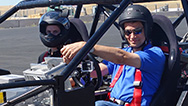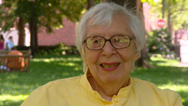Tiny Tattoo Vaccines
- Posted 08.14.14
- NOVA
The world can be a dangerous place, full of foes large and little. Take deadly infectious diseases. Host David Pogue considers a new kind of vaccine that might save millions of lives, while eliminating the need for refrigeration and scary needles.
Transcript
Tiny Tattoo Vaccines
Posted: September 5, 2014
What about protecting ourselves from the fires that flare up in our bodies? I'm talking about infectious diseases.
Vaccines are one of our greatest weapons against these deadly enemies. They've saved millions from polio, smallpox, measles, whooping cough and dozens of other illnesses. But delivering vaccines can be a challenge. Many need to be kept cold, and sometimes that's nearly impossible. And most require an injection. Where medical supplies are lacking, needles are sometimes re-used, which can spread disease. Bottom line: millions of people are not getting the vaccinations they need.
But I hear there's a team at M.I.T. working to overcome these obstacles. Scientist Pete DeMuth is developing a vaccine patch smaller than a dime.
So, what does this patch look like? It exists?
PETER DEMUTH (Massachusetts Institute of Technology): Yeah, it exists. You can take a look at a couple right here. And these needles are actually on the order of half a millimeter or less in length.
DAVID POGUE: So that'd be like this?
PETE DEMUTH: Exactly.
DAVID POGUE: And how many are there?
PETE DEMUTH: So, this patch actually has about 100 needles, but patches are made where there can be, even, thousands of needles.
DAVID POGUE: Looks harmless until you see it under the microscope.
PETE DEMUTH: All right, and then we'll bring this into focus.
DAVID POGUE: Whoa! Evil! Looks like a medieval torture device!
The next step is to coat these needles with fine layers, or films, that contain the vaccine. But how do you layer anything on something this small? You've got to know how to work at the nano-scale, down at the molecular level, like Professor Paula Hammond.
PAULA HAMMOND: Well, this is actually where we build the films that contain the vaccine.
DAVID POGUE: Hi, how are you doing?
PAULA HAMMOND: Yes, yes, we love our friend here.
DAVID POGUE: This is it, huh?
PAULA HAMMOND: This is it.
DAVID POGUE: A robotic arm dips the microneedle patch into trays containing the vaccine's components.
You, sort of, co-opted the ancient principle of chocolate fondue.
PAULA HAMMOND: The way that we make the coating, is that we take the components that make up our vaccine; one of the components is negatively charged, and the other component is positively charged.
DAVID POGUE: The microneedle patch is negatively charged. First, it's dipped in a positively-charged component and a microscopic layer forms. Then, it's dipped in a negatively-charged component, and a new layer forms. In this way, dozens of layers can be built up on the microneedles and then embedded in the skin, like a tattoo. Over days or weeks, they dissolve and release the vaccine.
But what are these components?
PAULA HAMMOND: The positively-charged ones are biodegradable polymers, in this case, plastics. And the negatively-charged ones are D.N.A.
DAVID POGUE: Wait, so, there's a polymer, and there's D.N.A., which is genetic material. I thought you said it's a vaccine.
PAULA HAMMOND: Actually, D.N.A., in our case, is the vaccine, which is very unique but also very powerful.
DAVID POGUE: Most vaccines are created from weakened or killed microbes, or from parts of microbes. The immune system mounts an attack, even though there's no real threat. Some immune cells remember the episode. Should they ever encounter the actual microbe, they'll spring into action and destroy the invader.
A D.N.A. vaccine doesn't deliver any bits of microbe. It delivers a stretch of D.N.A. that contains a gene for a bit of microbe, a protein. This gene inserts itself into our D.N.A. Now, our own cells produce proteins that trigger an immune response.
And the D.N.A. requires no refrigeration.
PETE DEMUTH: Okay, David, are you ready?
DAVID POGUE: Dude! In what universe is that a microneedle?
PAULA HAMMOND: We don't have to deal with this old technology anymore.
DAVID POGUE: Oh, that's the before, and this is the after.
PAULA HAMMOND: That was before, yeah.
DAVID POGUE: You guys are just a laugh riot.
PAULA HAMMOND: And I'm just going to apply this to your wrist.
DAVID POGUE: So, this is human trials, starting right now?
PAULA HAMMOND: Well, let's see how it goes.
All right. And we're going to place this right here.
DAVID POGUE: Ow!
It doesn't hurt at all.
PAULA HAMMOND: Just a little pressure.
DAVID POGUE: Like you're holding up a plastic game piece to my skin.
PAULA HAMMOND: It's really nice, because these microneedles are too short to reach the nerve endings in your skin.
DAVID POGUE: And, this particular one, what nasty D.N.A. is it injecting into my body?
PAULA HAMMOND: We didn't put anything on yours. This is just a blank to give you an idea of what the experience will be like.
DAVID POGUE: Wow. I don't see blood; I don't see shredded flesh, just that little ring.
PAULA HAMMOND: That's right, exactly.
DAVID POGUE: So, not only does this eliminate the problem with keeping the vaccine cold all the way from the manufacturer, not only does it solve the problem of needles being reused or misused, but it also doesn't hurt. Which you could argue, is an advantage over huge nasty pieces of metal.
PAULA HAMMOND: It's a huge advantage: no more crying children. You have happy parents, as well.
DAVID POGUE: Although, the one downside, I'd have to say, is that you don't get the little lollipop at the end for your suffering.
PAULA HAMMOND: We would like to give you a little lollipopâ¦
DAVID POGUE: Aren't you sweet?
PAULA HAMMOND: â¦for being such a great sport.
DAVID POGUE: It's a polymer!
This radical new vaccine system is still in the testing phase. If it lives up to its promise, it could eventually save millions of lives around the world.
Credits
- Host
- David Pogue
- Written by
- Gail Willumsen
- Produced and Directed by
- Gail Willumsen
Jill Shinefield - EXECUTIVE PRODUCER
- Chris Schmidt
- EDITED BY
- Tchavdar Georgiev
Joseph Kleinman - CAMERA
- Jason Longo
- ASSOCIATE PRODUCERS
- Sara Hutchison
Minna Kane
Olga Arana - ADDITIONAL CAMERA
- Kris Denton
Peter Bonilla - SOUND RECORDISTS
- Steve Bores
Dustin Eddo
Alexandra Gallo
Chris Kellett
Ken King
Drew Levinson
Dean Miller
Patrick Schaefer
John Toffolo
Warren Wolfe - MUSIC
- Christopher Rife
- ART DIRECTOR
- Ekin Akalin
- ANIMATION
- Smash5 Studios
- ADDITIONAL EDITING
- Dan McCabe
Brian Funck - ASSISTANT EDITORS
- Tiffany Melvin
Kevin Purcell - ONLINE EDITOR AND COLORIST
- Mark Needham
- AUDIO MIX
- Andrew Williams
- MUSIC EDITOR
- Zig Gron
- RESEARCH
- Barbara Moran
- ASSISTANTS TO DAVID POGUE
- Jan Carpenter
Cindy Love - ARCHIVAL MATERIAL
- CNN
Corbis
Department of Defense/US Customs
Framepool
Getty
Oddball Film + Video
T3Media
The WPA Film Library
UWTV
VA Boston/ Boston University - SPECIAL THANKS
- David Baker
Robert Beckley
Defense Threat Reduction Agency
Department of Homeland Security Science and Technology Directorate
Kevin Tod Haug
Institute for Protein Design, University of Washington
Ioana Patringenaru
Dan Radulescu
Jim Schenke
Smith Memorial Playground & Playhouse
John Verrico - ADVISORS
- Jim Collins
Tony DeRose
Dale Dougherty
Alex King
Tim McGee
Amy Moll
Mike Petrich
Ainissa Ramirez
Thea Sahr
Eric Siegel
Stephen Streiffer
Desney Tan
Jessika Trancik
Thomas Tretter
Phil Weilerstein - NOVA SERIES GRAPHICS
- yU + co.
- NOVA THEME MUSIC
- Walter Werzowa
John Luker
Musikvergnuegen, Inc. - ADDITIONAL NOVA THEME MUSIC
- Ray Loring
Rob Morsberger - CLOSED CAPTIONING
- The Caption Center
- POST PRODUCTION ONLINE EDITOR
- Michael H. Amundson
- PUBLICITY
- Eileen Campion
Eddie Ward - SENIOR RESEARCHER
- Kate Becker
- NOVA ADMINISTRATOR
- Kristen Sommerhalter
- PRODUCTION COORDINATOR
- Linda Callahan
- PARALEGAL
- Sarah Erlandson
- TALENT RELATIONS
- Scott Kardel, Esq.
Janice Flood - LEGAL COUNSEL
- Susan Rosen
- DIRECTOR OF EDUCATION
- Rachel Connolly
- DIGITAL MANAGING PRODUCER
- Kristine Allington
- SENIOR DIGITAL EDITOR
- Tim De Chant
- DIRECTOR OF NEW MEDIA
- Lauren Aguirre
- DEVELOPMENT ASSOCIATE
- Lisa Leombruni
- UNIT MANAGER
- Ariam McCrary
- PRODUCTION MANAGER
- Stephanie Mills
- POST PRODUCTION ASSISTANT
- Brittany Flynn
- POST PRODUCTION EDITOR
- Rebecca Nieto
- POST PRODUCTION MANAGER
- Nathan Gunner
- COMPLIANCE MANAGER
- Linzy Emery
- BUSINESS MANAGER
- Elizabeth Benjes
- DEVELOPMENT PRODUCER
- David Condon
- PROJECT DIRECTOR
- Pamela Rosenstein
- COORDINATING PRODUCER
- Laurie Cahalane
- SENIOR SCIENCE EDITOR
- Evan Hadingham
- SENIOR PRODUCER
- Julia Cort
- SENIOR SERIES PRODUCER
- Melanie Wallace
- MANAGING DIRECTOR
- Alan Ritsko
- SENIOR EXECUTIVE PRODUCER
- Paula S. Apsell
A NOVA Production by Gemini Productions LLC for WGBH/Boston
© 2013 WGBH Educational Foundation
All rights reserved
This program was produced by WGBH, which is solely responsible for its content.
IMAGE:
- Image credit: (David Pogue)
- Courtesy David Pogue
This is an excerpt from the NOVA program "Making Stuff Safer."
Related Links
-

Vaccines—Calling the Shots
Examine the science behind vaccinations, the return of preventable diseases, and the risks of opting out.
-

Making Stuff Safer
Host David Pogue examines groundbreaking research that aims to keep us out of harm's way.
-

Brushes with Death
Dorothy Roseman describes her close encounters with vaccine-preventable diseases.
-

Making Vaccines
How are vaccines made? Create six vaccines in our virtual laboratory, using a different technique to produce each one.

